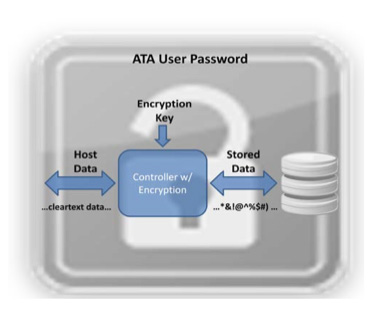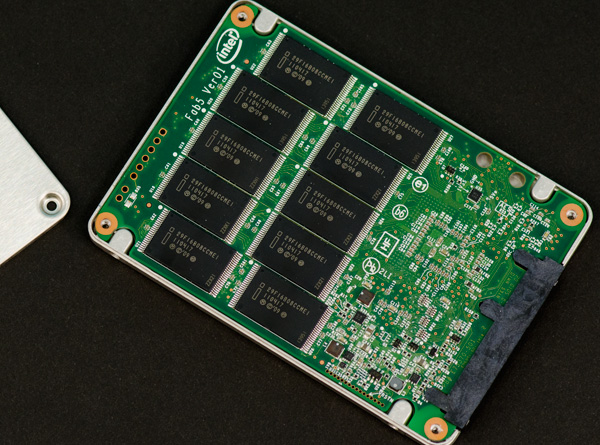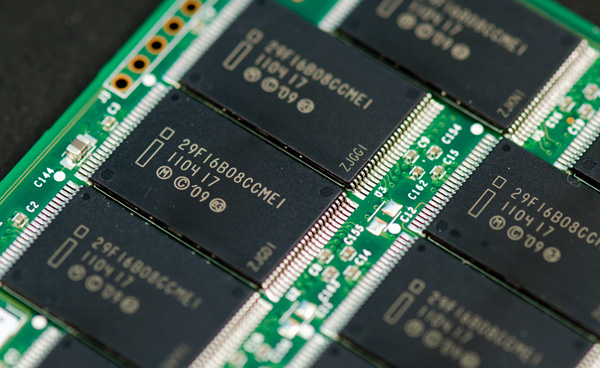The Intel SSD 320 Review: 25nm G3 is Finally Here
by Anand Lal Shimpi on March 28, 2011 11:08 AM EST- Posted in
- IT Computing
- Storage
- SSDs
- Intel
- Intel SSD 320
Spare Area and Redundant NAND
Intel's controller is a 10-channel architecture and thus drive capacities are still a little wonky compared to the competition. Thanks to 25nm NAND we now have some larger capacities to talk about: 300GB and 600GB.
Intel sent a 300GB version of the 320 for us to take a look at. Internally the drive has 20 physical NAND devices. Each NAND device is 16GB in size and features two 64Gbit 25nm 2-bit MLC NAND die. That works out to be 320GB of NAND for a drive whose rated capacity is 300GB. In Windows you'll see ~279GB of free space, which leaves 12.8% of the total NAND capacity as spare area.
Around half of that spare area is used to keep write amplification low and for wear leveling, both typical uses of spare area. The other half is for surplus NAND arrays, a RAID-like redundancy that Intel is introducing with the SSD 320.
As SandForce realized in the development of its controller, smaller geometry NAND is more prone to failure. We've seen this with the hefty reduction in rated program/erase cycles since the introduction of 50nm NAND. As a result, wear leveling algorithms are very important. With higher densities however comes the risk of huge amounts of data loss should there be a failure in a single NAND die. SandForce combats the problem by striping parity data across all of the NAND in the SSD array, allowing the recovery of up to a full NAND die should a failure take place. Intel's surplus NAND arrays work in a similar manner.
Instead of striping parity data across all NAND devices in the drive, Intel creates a RAID-4 style system. Parity bits for each write are generated and stored in the remaining half of the spare area in the SSD 320's NAND array. There's more than a full NAND die (~20GB on the 300GB drive) worth of parity data on the 320 so it can actually deal with a failure of more than a single 64Gbit (8GB) die.
Sequential Write Cap Gone, but no 6Gbps
The one thing that plagued Intel's X25-M was its limited sequential write performance. While we could make an exception for the G1, near the end of the G2's reign as most-recommended-drive the 100MB/s max sequential write speed started being a burden(especially as competing drives caught up and surpassed its random performance). The 320 fixes that by increasing rated sequential write speed to as high as 220MB/s.
You may remember that with the move to 25nm Intel also increased page size from 4KB to 8KB. On the 320, Intel gives credit to the 8KB page size as a big part of what helped it overcome its sequential write speed limitations. With twice as much data coming in per page read it's possible to have a fully page based mapping system and still increase sequential throughput.
Given that the controller hasn't changed since 2009, the 320 doesn't support 6Gbps SATA. We'll see this limitation manifest itself as a significantly reduced sequential read/write speed in the benchmark section later.
AES-128 Encryption
SandForce introduced full disk encryption starting in 2010 with its SF-1200/SF-1500 controllers. On SandForce drives all data written to NAND is stored in an encrypted form. This encryption only protects you if someone manages to desolder the NAND from your SSD and probes it directly. If you want your drive to remain for your eyes only you'll need to set an ATA password, which on PCs is forced by setting a BIOS password. Do this on a SandForce drive and try to move it to another machine and you'll be faced with an unreadable drive. Your data is already encrypted at line speed and it's only accessible via the ATA password you set.

Intel's SSD 320 enables a similar encryption engine. By default all writes the controller commits to NAND are encrypted using AES-128. The encryption process happens in realtime and doesn't pose a bottleneck to the SSD's performance.
The 320 ships with a 128-bit AES key from the factory, however a new key is randomly generated every time you secure erase the drive. To further secure the drive the BIOS/ATA password method I described above works as well.
A side effect of having all data encrypted on the NAND is that secure erases happen much quicker. You can secure erase a SF drive in under 3 seconds as the controller just throws away the encryption key and generates a new one. Intel's SSD 320 takes a bit longer but it's still very quick at roughly 30 seconds to complete a secure erase on a 300GB drive. Intel is likely also just deleting the encryption key and generating a new one. Without the encryption key, the data stored in the NAND array is meaningless.
The Test
| CPU |
Intel Core i7 965 running at 3.2GHz (Turbo & EIST Disabled) Intel Core i7 2600K running at 3.4GHz (Turbo & EIST Disabled) - for AT SB 2011, AS SSD & ATTO |
| Motherboard: |
Intel DX58SO (Intel X58) Intel H67 Motherboard |
| Chipset: |
Intel X58 + Marvell SATA 6Gbps PCIe Intel H67 |
| Chipset Drivers: |
Intel 9.1.1.1015 + Intel IMSM 8.9 Intel 9.1.1.1015 + Intel RST 10.2 |
| Memory: | Qimonda DDR3-1333 4 x 1GB (7-7-7-20) |
| Video Card: | eVGA GeForce GTX 285 |
| Video Drivers: | NVIDIA ForceWare 190.38 64-bit |
| Desktop Resolution: | 1920 x 1200 |
| OS: | Windows 7 x64 |













194 Comments
View All Comments
semo - Monday, March 28, 2011 - link
Anand, it has been a long time now. People are still confused about what is happening with the OCZ V2 drives. OCZ are still not issuing a recall of drives that are smaller and slower than what the packaging claims.OCZ will only react when the customer finds out through their own research what has happened and then confronts OCZ.
For those wanting to know more, see my thread below or research the OCZ Vertex 2 25nm transition fiasco.
http://forums.anandtech.com/showthread.php?t=21433...
The issue will not be resolved until OCZ recalls all affected products.
GeorgeH - Monday, March 28, 2011 - link
It looks like the crucial parts are physically identical to G2 drives. Intel may not offer updated firmware for G2 drives, but it looks like it might not be impossibly difficult to modify G3 firmware to work on G2 drives.Did Intel give any indication if the G2 controllers were physically different from the G3s? In other words did Intel take the laser scalpel to the G2 controllers or is it just a software restriction?
Chloiber - Monday, March 28, 2011 - link
Anand explained why the write performance is higher (4kB -> 8kB).GeorgeH - Monday, March 28, 2011 - link
Sure, but full disk encryption might be nice.Anand Lal Shimpi - Monday, March 28, 2011 - link
The G2 controller had the same features as the 320's controller. It's unclear whether they were tested/functional in the G2 era but they were there. The 320's controller is apparently the same physical die, just with these new features enabled/tested/validated.G1 owners didn't get TRIM, and I wouldn't expect G2 owners to get AES-128 via firmware. Sorry :(
bbbcase - Monday, March 28, 2011 - link
The Intel G1/G2 drives would eventually throttle write performance if you consistently wrote over 20GB/day on them to ensure warranty lifetime. This really limited their usefulness in certain server applications.Does the G3 have a similar throttling mechanism?
Chloiber - Monday, March 28, 2011 - link
?? They didn't. The block fragmentation will, in spite of TRIM increase (that's the case with pretty much every SSD). Write 0s sequentially on the empty space every 2 months and the performance will always be as it was on the first day.You can also do this by doing a Full Diagnostics Scan using the Intel SSD Toolbox (writes sequentially on the empty space).
toyotabedzrock - Monday, March 28, 2011 - link
I'm curious if a 8KB random R/W test would show a bump in speed beyond what other drives would see.Intel really needs to get serious about allocating people to the SSD and Chipset teams. They always make a quick leap with a great new chip then it languishes for years with minor updates.
Pentium 4 flashbacks!
cdbob - Monday, March 28, 2011 - link
I heard rumors that pricing was going to be on the steep side. It's too bad this turned out to be true, Intel better lower the price of their drives quick or they're going to start eating some serious dust when the next crop of Crucial Drives come out.Beenthere - Monday, March 28, 2011 - link
That's why I won't buy any SSD for at least five more years. Poor reliability and data loss don't work for me.